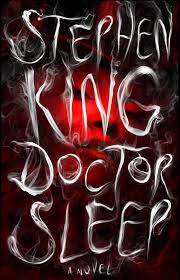Book review Tuesday: Doctor Sleep, by Stephen King
A while back, I wrote about reading Stephen King’s The Shining, and the surprising discovery that it blows the movie of the same name out of the water. As you can imagine, when I found out that King had come out with a sequel to The Shining, I pre-ordered that business immediately. So, last month, I bought and devoured Doctor Sleep, King’s follow-up to The Shining, within a few days. It turned out to be one of those books that I had trouble putting down. I read it on the Tube, in waiting rooms, and before bed. And when I finished it, it stuck with me. It’s taken me almost a month to write this review because I’ve been doing other things (like writing a new novel!), but the fact that the book is still fresh in my mind a month later is a testament to Stephen King’s ever- impressive storytelling abilities.
Doctor Sleep skips forward several decades from the end of The Shining and focuses on Dan Torrance, the preternaturally gifted son of Wendy and Jack Torrance, who is now all grown up and an alcoholic, just like his father. At the beginning of the book, Dan is a wreck. He drinks, does drugs, has high-risk sex, and is generally miserable. After a particularly traumatic experience following a drugs/booze/sex bender, he escapes to a small New Hampshire town where, with the help of a few compassionate people, starts to remake his life. He gets clean and sober, secures a job as a caretaker at a hospice, and becomes active in his local Alcoholics Anonymous chapter. Things are good. But Dan is still affected by the “shining,” the ability to see into the future and read people’s thoughts. One day, Dan starts receiving messages from someone named Abra, who needs his help. Abra, we learn, is a young girl in a nearby town who is endowed with a very powerful dose of the shining. She is being pursued by a sinister group of beings called the True Knot, who seek to kill children with the shining and feed on their “steam,” or supernatural essences. The True Knot disguise themselves as “RV people” and travel unnoticed across the country, murdering children and using the children’s steam to bolster their own powers. Abra and Dan must band together to defeat the True Knot and its scary, beautiful ringleader, Rose the Hat. As Dan is pulled deeper into Abra’s dilemma, he struggles with his demons: memories of his father, the urge to drink, and his own regrets.
The book, like every Stephen King book I’ve read, is a page-turner. The plot is fast-paced and gripping and the reader is made to care deeply about the characters, particularly Dan, who we’ve known since he was a child wandering the haunted halls of the Overlook Hotel. But the book also goes deep into Dan’s struggle with alcoholism, to moving effect. The Shining was also about alcoholism: it portrayed a man in the grips of a disease that was destroying him and his family. Doctor Sleep, meanwhile, is about a man who trying to swim against the destructive tide of his addiction, and mostly succeeding. King wrote The Shining when he was in the dark depths of his battle with alcoholism; he wrote Doctor Sleep after decades of sobriety. The most noticeable difference in perspective between these two books is that, unlike The Shining, Doctor Sleep offers hope for redemption even for people who have messed up their lives profoundly with drugs and alcohol. The Shining was about survival: getting out of the Overlook before it exploded. Doctor Sleep, though, is about creating a life worth living after escaping the wreckage.
This novel is highly recommended for Stephen King fans and anyone looking for a quick but emotionally satisfying page-turner. One word of advice: read (or re-read) The Shining first. It helps to have the original novel fresh in your mind as you delve into the world of Dan Torrence.
In case you’re interested, here’s what Margaret Atwood writing for the NY Times had to say.

1 Comment-
Pingback: Book review: eight short reviews to round out 2014 | Stephanie Early Green